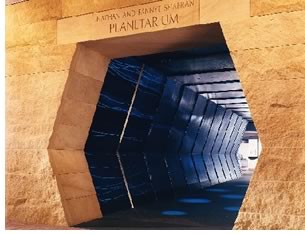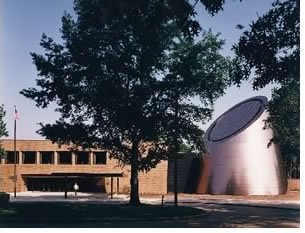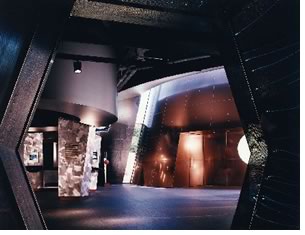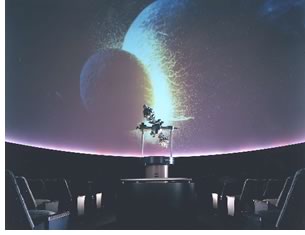

Designing for the Stars
Cleveland’s new planetarium evokes
an astronomic instrument
 The
newest addition to the Cleveland Museum of Natural History, the Nathan
and Fannye Shafran Planetarium by van Dijk Westlake Reed Leskosky, suggests
a sleek, futuristic identity. A metal-clad, chamfered cone, this sculptural
addition angles toward and aligns with the North Star. The striking shape
and bronze color of the 60-foot-tall planetarium heralds the museum’s
current effort to transform itself through a series of modestly scaled
facilities. This museum in particular aims to appeal to school children
and repeat visitors through up-to-date technology, equipment, and live
programming.
The
newest addition to the Cleveland Museum of Natural History, the Nathan
and Fannye Shafran Planetarium by van Dijk Westlake Reed Leskosky, suggests
a sleek, futuristic identity. A metal-clad, chamfered cone, this sculptural
addition angles toward and aligns with the North Star. The striking shape
and bronze color of the 60-foot-tall planetarium heralds the museum’s
current effort to transform itself through a series of modestly scaled
facilities. This museum in particular aims to appeal to school children
and repeat visitors through up-to-date technology, equipment, and live
programming.
For this project, the architects asked themselves how to take a program that is “traditionally circular in shape, domical in section, and devoid of windows and transform it into memorable architecture.” They soon found their answer. “We accepted its geometry, but treated it as sculpture, shaping it as a chamfered cone angled toward the North Star and resonating with a bronze color metal skin. The planetarium functions as an astronomic instrument, imbued with iconic and educational meaning,” said Paul Westlake Jr., FAIA, principal of Cleveland-based architecture and engineering firm. The architects took further direction from the museum’s educational emphasis and the other cultural buildings that provide context for the planetarium, including the city’s botanical gardens, the Cleveland Museum of Art, and Western Reserve Historical Society.
 Inspiration
from Polaris
Inspiration
from Polaris
At its highest point, the conical form is about as tall as it is wide
at the ground. The chamfer through the cone creates an elliptical cross-section
whose longitudinal axis is aligned at precisely 41.5 degrees, the viewing
angle to Polaris (the North Star) at Cleveland’s latitude. The architects
say this combination of angle and orientation will always place the North
Star hovering at the tip of the cone. Because all constellations appear
to rotate around Polaris, the exterior cone form and its orientation,
in effect, does function as an astronomic instrument. If the cone’s
titanium-nitride-sputtered, 14-gauge stainless steel plate brushed with
an angel-haired finish is reminiscent of finely machined brass and bronze
astronomic instruments, that was purposeful: the architects carefully
selected the material and color to obtain a finish and appearance that
would evoke traditional astronomical and viewing instruments. The architects
note that they chose the material because it will not discolor, patina,
chalk, or corrode overtime.
 The
steel-frame structure is clad with cement board and covered with self-healing
waterproof membrane. “The metal skin system is complicated by the
fact that panels are trapezoidal in shape, yet their tops and bottoms
actually take the form of arcs, with the tops having a sharper radius,
explained Phillip Schroeder, AIA, a van Dijk Reed Leskosky associate.
“The panels must be cut to a specific shape, curved and applied
to the conical form so that the arcs appear as a straight line and horizontal
element when viewed.” Tom Tormey, a museum trustee and chairman
of the Building Grounds and Construction Committee, seconded these comments:
"This was an incredibly complex project, with no straight corners."
The
steel-frame structure is clad with cement board and covered with self-healing
waterproof membrane. “The metal skin system is complicated by the
fact that panels are trapezoidal in shape, yet their tops and bottoms
actually take the form of arcs, with the tops having a sharper radius,
explained Phillip Schroeder, AIA, a van Dijk Reed Leskosky associate.
“The panels must be cut to a specific shape, curved and applied
to the conical form so that the arcs appear as a straight line and horizontal
element when viewed.” Tom Tormey, a museum trustee and chairman
of the Building Grounds and Construction Committee, seconded these comments:
"This was an incredibly complex project, with no straight corners."
Fiber-optic lighting gives the planetarium a nighttime presence without casting a harsh light into the sky. “At night, it is articulated by a grid of points of light, ordering the heavens and set in geometric relationship with the stars. The result is a dialogue between the randomness of the lights in the sky and frozen grid of light,” Westlake said, referring to the 440 fiber-optic points that reveal the cone shape in the evening hours.
 Interior
detail
Interior
detail
The entranceway is designed as a 50-foot connective tissue, linking the
cone form with the existing brick-clad building. The octagonal walls are
fashioned from perforated metal. Sound bites from past space flights transport
visitors from earth to space. Fiber-optic cables running the length of
the passageway create a random pattern, and in the astronomy exhibit hall,
the walls are painted a speckled black. Darkly tinted glass blocks light
from the exhibit hall, but still reveal the full form of the planetarium’s
cone from the perspective of the interior.
 The
planetarium’s all-dome video projection system, the most advanced
of which projects more than 5,000 celestial images onto the 40-foot suspended
perforated aluminum dome, is surrounded by 86 auditorium seats. This,
along with the presenter’s seat, equals the number of constellations
in the sky. The set-up allows for personalized instruction to school children,
complemented by an interactive “hands-on” learning experience,
computerized exhibit hall, and the museum’s historical collection
of celestial objects.
The
planetarium’s all-dome video projection system, the most advanced
of which projects more than 5,000 celestial images onto the 40-foot suspended
perforated aluminum dome, is surrounded by 86 auditorium seats. This,
along with the presenter’s seat, equals the number of constellations
in the sky. The set-up allows for personalized instruction to school children,
complemented by an interactive “hands-on” learning experience,
computerized exhibit hall, and the museum’s historical collection
of celestial objects.
Project Director Amy Dibner, AIA, another van Dijk Westlake Reed Leskosky associate, acknowledged the effort and technical complexity involved in an innovative undertaking. “Because this project has been so exciting and innovative, everyone involved in it has felt passionate about it,” she said.
Copyright 2003 The American Institute of Architects.
All rights reserved. Home Page ![]()
![]()
 |
||
| Images © Nick Merrick, Hedrich Blessing
|
||